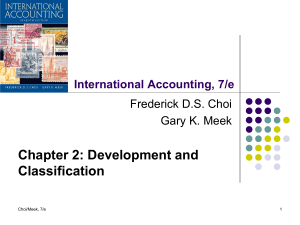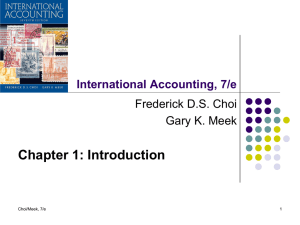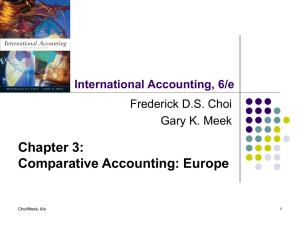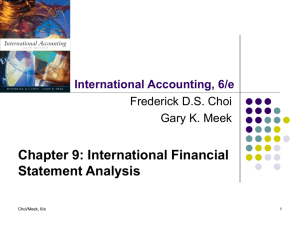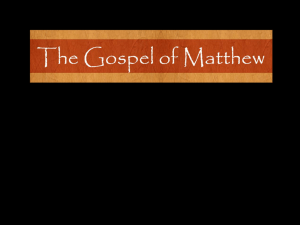Chapter 2 New Book
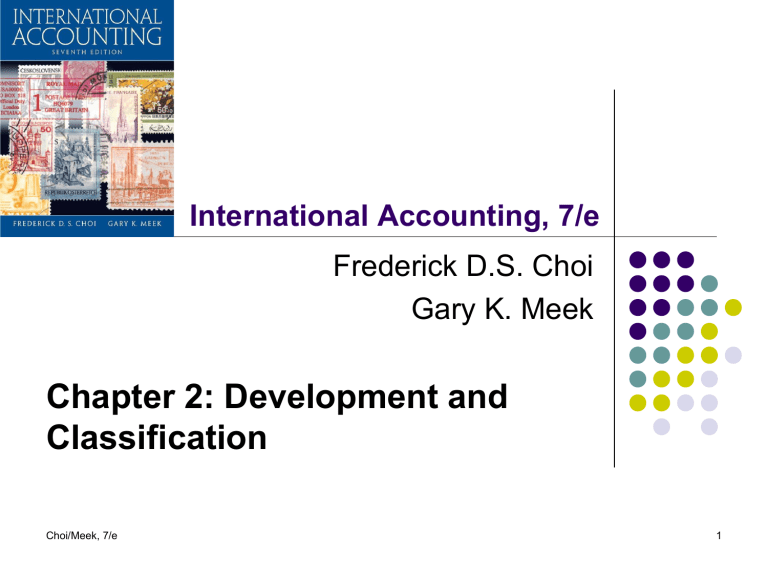
International Accounting, 7/e
Frederick D.S. Choi
Gary K. Meek
Chapter 2: Development and
Classification
Choi/Meek, 7/e 1
Learning Objectives
Identify and understand the importance of the eight factors that have a significant influence on accounting development.
Understand the four approaches to accounting development found in market-oriented Western economies and identify countries in which each approach is prevalent.
Have a basic working knowledge of accounting classifications and how they compare with one another.
Explain the difference between the “fair presentation” and
“legal compliance” orientations of accounting and identify nations in which each is prevalent.
Explain why distinctions of accounting at the national level are becoming blurred.
Choi/Meek, 7/e 2
Why Study Development and
Classification?
Development
Helps understand a nation’s accounting.
Explains the differences and similarities in accounting around the world.
Classification
Helps understand why and how national accounting systems differ.
Helps analyze whether these systems are converging or diverging.
Are a way of viewing the world.
Reveals what group members have in common, and
What distinguishes groups from each other
Choi/Meek, 7/e 3
Development
Sources of finance – who, how many, how close?
Equity markets
Profits measure how well managers have run the company.
Accounting is used to assess cash flows, risks, and to value the firm.
Extensive disclosures.
Banks
Conservative earnings for creditor protection.
Less extensive disclosures.
Choi/Meek, 7/e 4
Development (contin)
Legal system
Code law
Laws are all-embracing.
Accounting tends to be prescriptive and procedural.
Accounting focuses on legal form.
Accounting standards and procedures are incorporated into national laws.
Common law
Laws develop on a case-by-case basis.
Accounting develops from experience and judgment.
Accounting tends to be flexible, adaptive, and innovative.
Accounting focuses on economic substance.
Accounting rules are established by private sector professional organizations.
Choi/Meek, 7/e 5
Development (contin)
Taxation
Must companies record revenues and expenses in their accounts to claim them for tax purposes?
Are financial accounting and taxation the same?
Or are they different?
Political and economic ties
Accounting ideas and technologies are transferred through conquest, commerce, and other forces.
Inflation
Inflation distorts historical cost measurements.
Countries with high inflation often require that companies incorporate price changes into the accounts.
Choi/Meek, 7/e 6
Development (contin)
Level of economic development
Affects the types of transactions and which ones are most prevalent in the economy which, in turn,
Affects the accounting issues that are faced.
Educational level
Affects the capability for professional accounting training.
Where education levels are low, countries import accounting training or send citizens elsewhere to get it.
SUMMARY
Several variables are closely associated.
Common law legal system, strong equity markets, and separation of financial and tax accounting.
Code law legal system, credit-based financing, and accounting rules that conform to tax law.
Result is two basic orientations of accounting.
Fair presentation
Legal compliance
Choi/Meek, 7/e 7
Development (contin)
Culture and accounting values
Culture (Hofstede)
Individualism vs. collectivism
Power distance – high vs. low
Uncertainty avoidance – high vs. low
Masculinity vs. femininity
Accounting values (Gray)
Professionalism vs. statutory control
Uniformity vs. flexibility
Conservatism vs. optimism
Secrecy vs. transparency
Choi/Meek, 7/e 8
Development (contin)
Linking the two:
Choi/Meek, 7/e 9
Classification
Four approaches to accounting development (Mueller 1967)
Macroeconomic approach
Accounting derived from and designed to enhance national macroeconomic goals.
Example: Sweden
Microeconomic approach
Accounting derived from microeconomics.
Maintaining physical capital
Separation of capital and income
Replacement costs
Example: the Netherlands
Independent discipline approach
Accounting derived from business practices, judgment, and trial-and-error.
Examples: U.K. and U.S.
Uniform approach
Accounting is standardized by central government and used as a tool for administrative control.
Example: France
Choi/Meek, 7/e 10
Classification (contin)
Legal systems: common law vs. code law accounting
Common law accounting
Oriented toward fair presentation, transparency, and full disclosure
Separation between tax and financial accounting
Accounting standard setting in private sector
Parallels stockholder model of corporate governance
Code law accounting
Legalistic orientation, opaque with low disclosure
Alignment between tax and financial accounting
Accounting standard setting in public sector
Parallels stakeholder model of corporate governance
Choi/Meek, 7/e 11
Classification (contin)
Practice systems: fair presentation versus legal compliance accounting
Why national accounting distinctions are becoming blurred
Importance of stock markets as a source of finance is growing.
Dual financial reporting is becoming more common, particularly where duality is sanctioned.
Some code law countries are shifting responsibility for accounting standard setting to the private sector.
Fair presentation accounting
Substance over form.
Oriented toward decision needs of external investors.
Helps judge managerial performance and predict future cash flows and profitability
Extensive disclosures
IFRS are aimed at fair presentation.
Found in U.K., U.S., Netherlands and countries influenced by them.
The trend for consolidated financial statements.
Choi/Meek, 7/e 12
Classification (contin)
Legal compliance accounting
Designed to satisfy government-imposed requirements, such as:
Calculating taxable income
Complying with macroeconomic plan
Conservative measurements
Income smoothing
Will persist in code law countries for individualcompany financial statements
Choi/Meek, 7/e 13
Other Chapter Exhibit
Choi/Meek, 7/e 14
